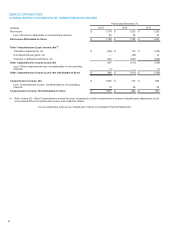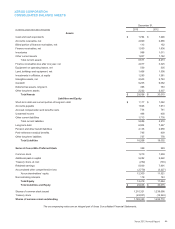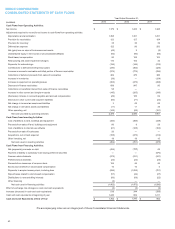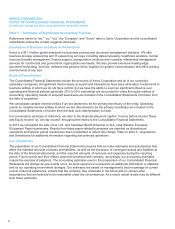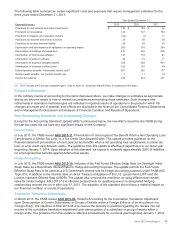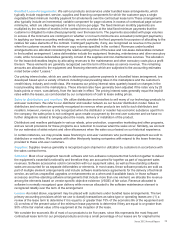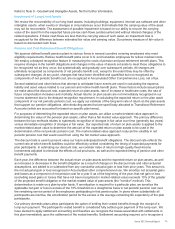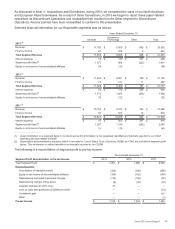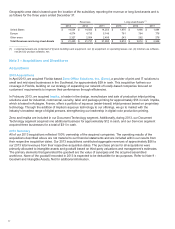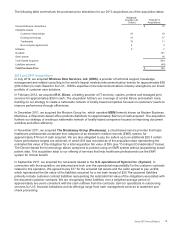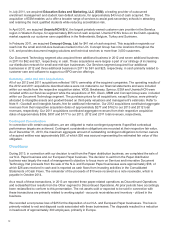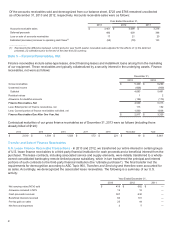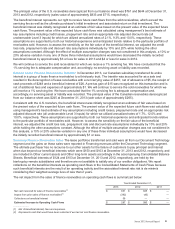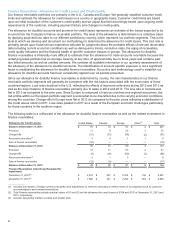Xerox 2013 Annual Report Download - page 90
Download and view the complete annual report
Please find page 90 of the 2013 Xerox annual report below. You can navigate through the pages in the report by either clicking on the pages listed below, or by using the keyword search tool below to find specific information within the annual report.obsolete raw materials and equipment inventories is based primarily on near term forecasts of product demand and
include consideration of new product introductions, as well as changes in remanufacturing strategies. The provision
for excess and/or obsolete service parts inventory is based primarily on projected servicing requirements over the
life of the related equipment populations.
Land, Buildings and Equipment and Equipment on Operating Leases
Land, buildings and equipment are recorded at cost. Buildings and equipment are depreciated over their estimated
useful lives. Leasehold improvements are depreciated over the shorter of the lease term or the estimated useful life.
Equipment on operating leases is depreciated to estimated salvage value over the lease term. Depreciation is
computed using the straight-line method. Significant improvements are capitalized and maintenance and repairs are
expensed. Refer to Note 6 - Inventories and Equipment on Operating Leases, Net and Note 7 - Land, Buildings,
Equipment and Software, Net for further discussion.
Software - Internal Use and Product
We capitalize direct costs associated with developing, purchasing or otherwise acquiring software for internal use
and amortize these costs on a straight-line basis over the expected useful life of the software, beginning when the
software is implemented (Internal Use Software). Costs incurred for upgrades and enhancements that will not result
in additional functionality are expensed as incurred. Amounts expended for Internal Use Software are included in
Cash Flows from Investing.
We also capitalize certain costs related to the development of software solutions to be sold to our customers upon
reaching technological feasibility (Product Software). These costs are amortized based on estimated future
revenues over the estimated economic life of the software. Amounts expended for Product Software are included in
Cash Flows from Operations. We perform periodic reviews to ensure that unamortized Product Software costs
remain recoverable from estimated future operating profits (net realizable value or NRV). Costs to support or service
licensed software are charged to Costs of services as incurred.
Refer to Note 7 - Land,Buildings, Equipment and Software, Net for further information.
Goodwill and Other Intangible Assets
Goodwill represents the excess of the purchase price over the fair value of acquired net assets in a business
combination, including the amount assigned to identifiable intangible assets. The primary drivers that generate
goodwill are the value of synergies between the acquired entities and the company and the acquired assembled
workforce, neither of which qualifies as an identifiable intangible asset. Goodwill is not amortized but rather is tested
for impairment annually or more frequently if an event or circumstance indicates that an impairment loss may have
been incurred.
Impairment testing for goodwill is done at the reporting unit level. A reporting unit is an operating segment or one
level below an operating segment (a "component") if the component constitutes a business for which discrete
financial information is available, and segment management regularly reviews the operating results of that
component.
When testing goodwill for impairment, we may assess qualitative factors for some or all of our reporting units to
determine whether it is more likely than not (that is, a likelihood of more than 50 percent) that the fair value of a
reporting unit is less than its carrying amount, including goodwill. Alternatively, we may bypass this qualitative
assessment for some or all of our reporting units and perform a detailed quantitative test of impairment (Step 1). If
we perform the detailed quantitative impairment test and the carrying amount of the reporting unit exceeds its fair
value, we would perform an analysis (Step 2) to measure such impairment. In 2013, we elected to proceed to the
quantitative assessment of the recoverability of our goodwill balances for each of our reporting units in performing
our annual impairment test. Based on our quantitative assessments, we concluded that the fair values of each of
our reporting units in 2013 exceeded their carrying values and no impairments were identified.
Other intangible assets primarily consist of assets obtained in connection with business acquisitions, including
installed customer base and distribution network relationships, patents on existing technology and trademarks. We
apply an impairment evaluation whenever events or changes in business circumstances indicate that the carrying
value of our intangible assets may not be recoverable. Other intangible assets are amortized on a straight-line basis
over their estimated economic lives. We believe that the straight-line method of amortization reflects an appropriate
allocation of the cost of the intangible assets to earnings in proportion to the amount of economic benefits obtained
annually by the Company.
73


